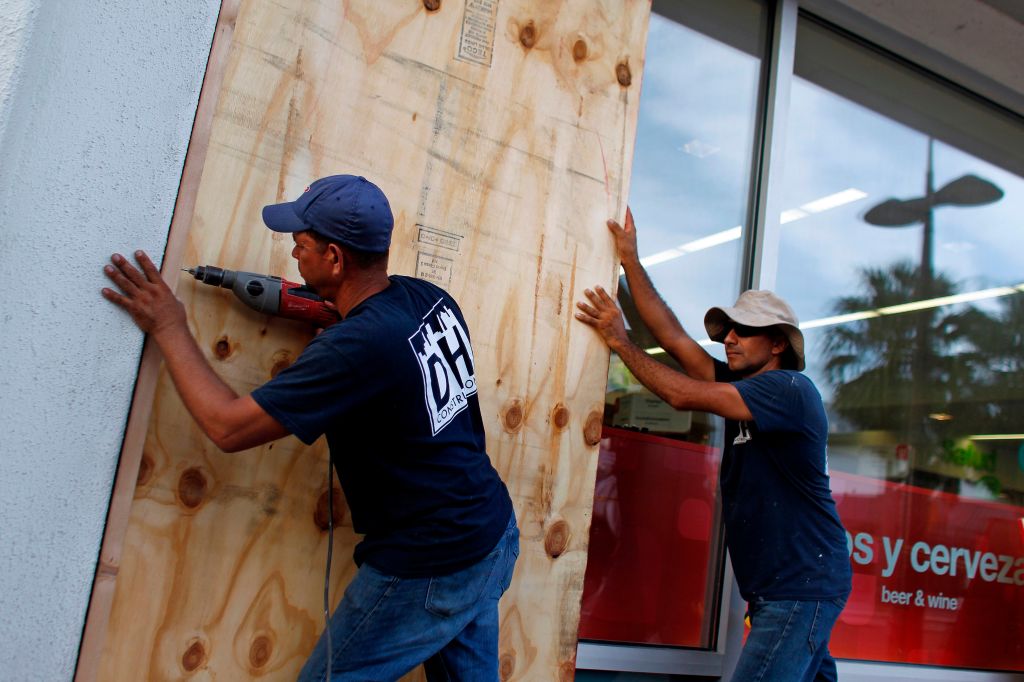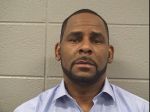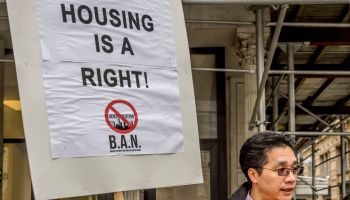
Source: RICARDO ARDUENGO / Getty
SAN JUAN, PUERTO RICO – Hurricane Maria slammed Puerto Rico Wednesday as thousands huddled in shelters and millions more hunkered down for a multi-hour barrage of 140-plus mph winds, horizontal rain and extensive flooding.
“God is with us,” Gov. Ricardo Rosselló tweeted shortly after Maria made landfall as the strongest hurricane to hit the island in almost a century. “We are stronger than any hurricane. Together we will rise.”
The entire island of 3.5 million people is without power, according to San Juan’s mayor.
More than 11,000 people sought refuge in about 500 shelters prepared by the government, Rosselló said. Most residents opted to ride out the storm in concrete homes and buildings.
The devastation came as the island, a decade deep in recession and led by a government struggling to pay its bills, wrestled with a massive recovery effort after Hurricane Irma. A glancing blow from that storm two weeks ago damaged buildings and knocked out power to a third of homes and businesses.
Video from Maria’s carnage showed roofs blown off some homes while others were smashed by fallen trees. Windows were blown out of high-rise buildings, and in some places plywood that had been nailed over windows had blown away.
In Carolina, 10 miles southeast of San Juan, managers at the Courtyard Marriott Isla Verde assured guests that backup generators could provide power to the hotel for days. As the storm rolled in, lights and power were working and hot coffee was being served.
But in Cataño, a city of 28,000 across San Juan Bay from San Juan, Mayor Felix Delgado told local media that homes and municipal buildings were severely damaged.
“This generation is going to build the new Cataño,” Delgado said. “We have to build the new Cataño after Maria.”
Major damage to island infrastructure was a concern. Cellphone towers toppled in the wind, and communication was difficult if not impossible. Flooding was rampant, and rescuers were mostly locked in place, waiting for the worst to pass.
FEMA Administrator Brock Long said his agency had 3,200 personnel “well positioned” to help after the storm.
“Our search & rescue teams are ready to support Puerto Rico & the U.S. Virgin Islands following #Maria,” FEMA tweeted.
Maria roared onto the island in the town of Yabucoa as a Category 4 hurricane with maximum sustained winds of more than 150 mph, according to the National Hurricane Center. At 11 a.m. ET Wednesday, the storm was packing winds of 140 mph, about 25 miles west of San Juan and moving northwest at 12 mph.
“Destructive winds and flooding continue over portions of Puerto Rico,” the hurricane center said.
Maria is expected to remain a dangerous major hurricane through Friday, the hurricane center said. The storm remains several days away from the continental U.S., and forecasters say Maria’s most likely path has it turning north without making landfall in Florida or elsewhere on the East Coast.
As Maria approached, authorities warned that people in low-lying areas needed to evacuate or they would die.
“This is going to be an extremely violent phenomenon,” Rosselló warned as Maria approached. “We have not experienced an event of this magnitude in our modern history.”
In Florida, Satellite Beach resident Erika Rodriguez said she last spoke to her family members Tuesday evening as the storm bore down. Rodriguez, like millions of others with connections to Puerto Rico, was waiting for lines of communication to improve.
“We haven’t heard anything at all. Not a word,” said Rodriguez, who has been watching various Spanish-language news sources for information. “All we can do now is gret ready, pray and wait.”
READ MORE: WKYC.com
Article Courtesy of USA Today, TEGNA, and WKYC Channel 3 News Cleveland
Picture Courtesy of Ricardo Arduengo and Getty Images
Tweet Courtesy of Twitter, USA Today, TEGNA, and WKYC Channel 3 News Cleveland
















